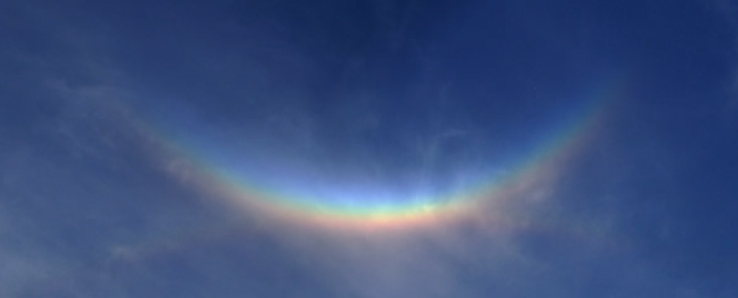Circumzenithal Arc
The Enchanting Phenomenon of the Circumzenithal Arc
When it comes to atmospheric optics, one of the most captivating and awe-inspiring phenomena is the circumzenithal arc (CZA). This ethereal display of colors, often referred to as an "upside-down rainbow," is a sight to behold. Imagine a rainbow that has escaped its watery origins and gracefully wrapped itself around the zenith, creating a grin in the sky. It is truly a spectacle that leaves observers mesmerized.
To catch a glimpse of the circumzenithal arc, one must look straight up near the zenith, particularly when the sun is at a relatively low position in the sky. This phenomenon is more likely to occur when sundogs, which are bright spots on either side of the sun, are also visible. The CZA is characterized by its center always facing towards the sun and with red hues on the outer edges.
Unlike a traditional rainbow that forms a complete circle, the circumzenithal arc does not encompass the entire zenith. Instead, it appears as an arc that stretches from one side of the sky to the other, creating a mesmerizing display of vibrant colors. However, it is essential to note that the Kern arc, an exceptionally rare phenomenon, does form a complete circle around the zenith.
The beauty of the CZA lies in its intricate formation. It occurs due to the refraction and reflection of sunlight by ice crystals in the atmosphere. These ice crystals, typically found in high-altitude cirrus clouds, act as prisms that separate sunlight into its constituent colors. As sunlight passes through these ice crystals, it undergoes multiple reflections and refractions, resulting in the formation of the CZA.
To understand the science behind this phenomenon, it is crucial to grasp the concept of ice crystal geometry. The shape and orientation of these ice crystals play a vital role in determining the characteristics of the CZA. The most common type of ice crystal associated with the formation of the CZA is the hexagonal plate crystal. These flat, hexagonal crystals have specific angles and orientations that lead to the bending and dispersion of sunlight, ultimately creating the beautiful arc.
The circumzenithal arc is not only a visual delight but also a testament to the complexity of atmospheric optics. Its presence serves as a reminder of the intricate interplay between sunlight, ice crystals, and atmospheric conditions. This phenomenon is a captivating example of how nature can transform everyday occurrences into breathtaking spectacles.
In addition to its aesthetic appeal, the CZA also holds scientific significance. Scientists and researchers study this phenomenon to gain insights into atmospheric conditions, such as the presence of cirrus clouds and the distribution of ice crystals within them. By understanding the formation and characteristics of the CZA, scientists can further their knowledge of atmospheric processes and improve weather prediction models.
To fully appreciate the wonder of the circumzenithal arc, it is crucial to seek out optimal viewing conditions. As mentioned earlier, a low sun position and the presence of sundogs increase the likelihood of witnessing this extraordinary spectacle. Additionally, being in an area with high-altitude cirrus clouds can enhance the chances of observing the CZA.
So, the next time you find yourself gazing at the sky on a sunny day, take a moment to look towards the zenith. Who knows, you might be lucky enough to witness the elusive and enchanting circumzenithal arc. Let this captivating display remind you of the intricate beauty that exists within our atmosphere and the wonders that nature has in store for us.

Circumzenithal arc, Atacama Desert, Chile. Imaged at the European Southern Observatory by Sylvain Rondi (site) on the morning of 21st March '02 when the sun was 22° high, the ideal altitude for CZAs. Image©2002 Sylvain Rondi, shown with permission.
The circumzenithal arc, CZA, is the most beautiful of all the halos. The first sighting is always a surprise, an ethereal rainbow fled from its watery origins and wrapped improbably about the zenith. It is often described as an "upside down rainbow" by first timers. Someone also charmingly likened it to "a grin in the sky".
Look straight up near to the zenith when the sun if fairly low and especially if sundogs are visible. The centre of the bow always sunwards and red is on the outside.
The CZA is never a complete circle around the zenith, that is the exceptionally rare and only recently photographed Kern arc.
Note: this article has been automatically converted from the old site and may not appear as intended. You can find the original article here.
Reference Atmospheric Optics
If you use any of the definitions, information, or data presented on Atmospheric Optics, please copy the link or reference below to properly credit us as the reference source. Thank you!
-
<a href="https://atoptics.co.uk/blog/circumzenithal-arc/">Circumzenithal Arc</a>
-
"Circumzenithal Arc". Atmospheric Optics. Accessed on April 27, 2024. https://atoptics.co.uk/blog/circumzenithal-arc/.
-
"Circumzenithal Arc". Atmospheric Optics, https://atoptics.co.uk/blog/circumzenithal-arc/. Accessed 27 April, 2024
-
Circumzenithal Arc. Atmospheric Optics. Retrieved from https://atoptics.co.uk/blog/circumzenithal-arc/.